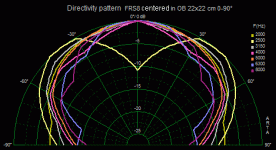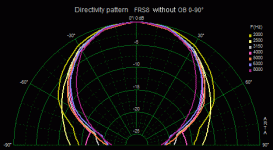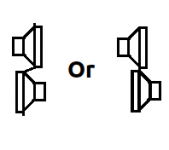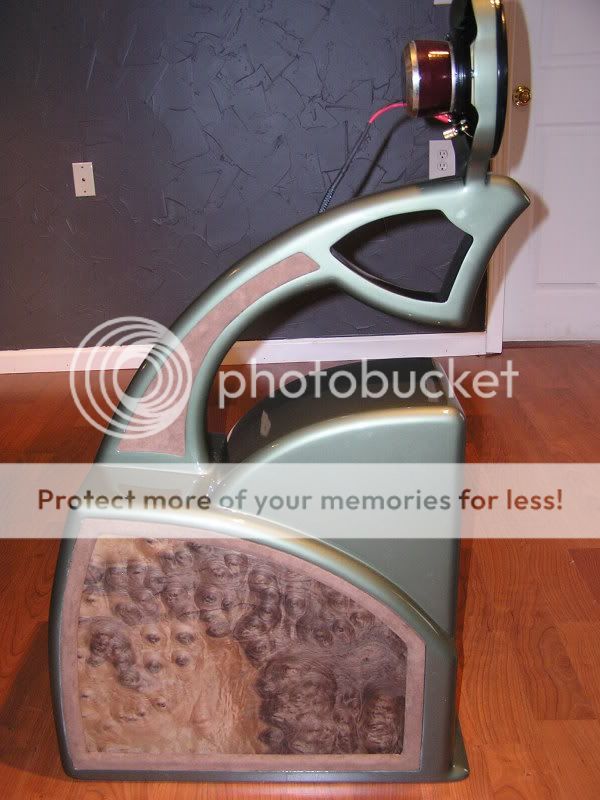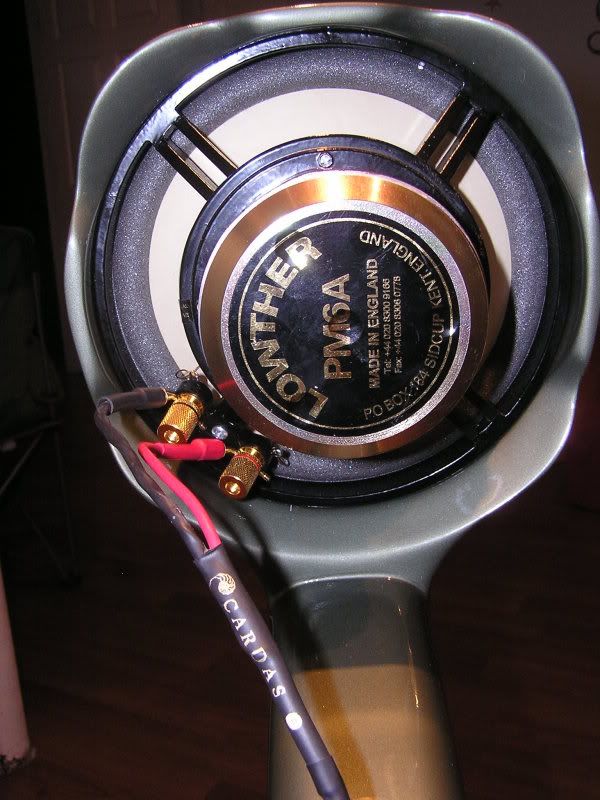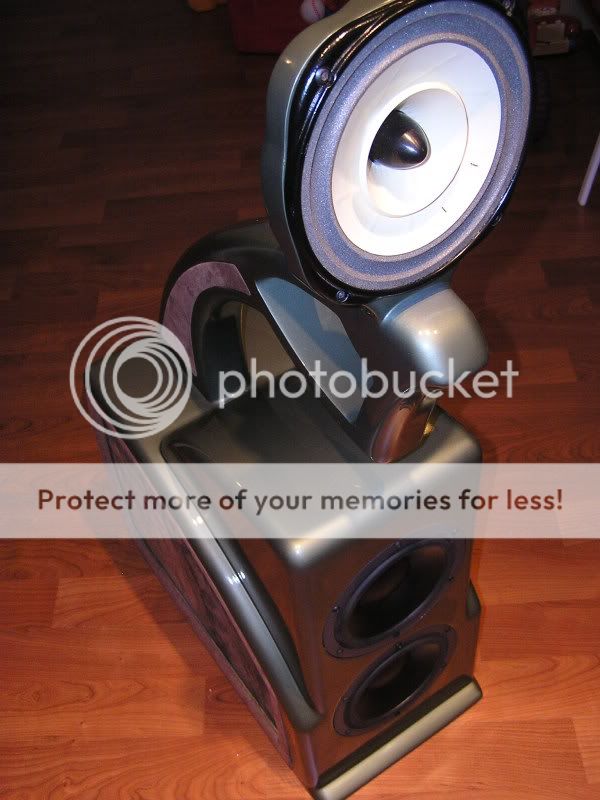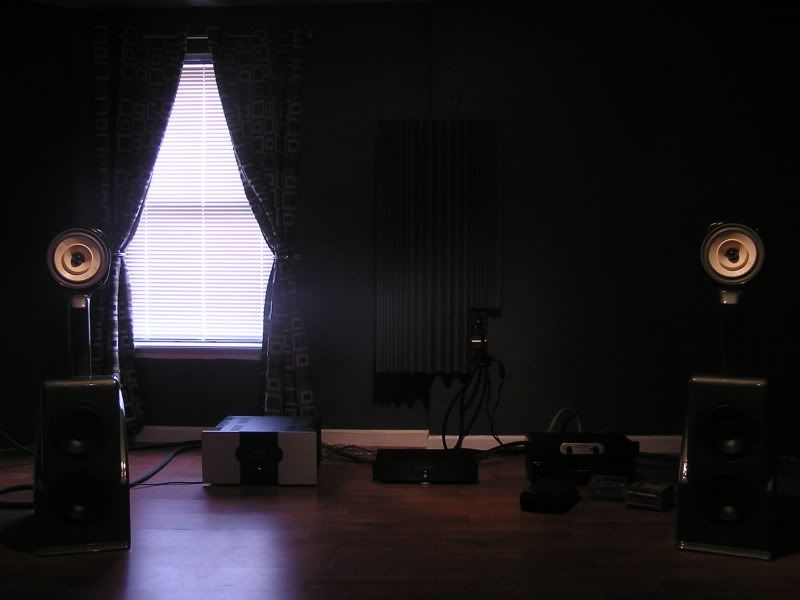Im sorry but, both of the last comments totaly left out the fact that few, make that very few, were recoroded with only two mics, sinse your listening to only two speakers? And, the benifits of OB/Dipole might improve the listening experience by taking your room out of the equation. Physics, nor memory of your favorite system can be compared to others description of the best they've herd, on well done systems. Have these poster's heard a good example of Dipole or well executed OB?
Can you explain flg how dipole speakers take the room out of the equation? Sure, there is some help is lower regions because of the figure 8 radiation pattern, but after that I don't see how the room is taken out.
Also, physics is physics. Dipole bass requires big cone areas and no baffle bass would require even more area.
Yes, these are my observations, colored by my experiences. But I'm just sharing them and hoping to learn something from the others.
Oh and I have heard the Orions. Superbly executed speakers. They disappear, they are very neutral and flat. But for that kind of money I expected more. I found them too insipid for my taste. They feel like they're going at 50 mph with the handbrake on. Of course, this is based on a single listening session and I may change my opinion of them if I had them in my living room. But that ain't going to happen and that's all I have to go on.
By all means design a no baffle speaker. It can be and it can sound good. But with a little bit of wood you can get all the goodness of OB and none of the issues with having no baffle.
Also, physics is physics. Dipole bass requires big cone areas and no baffle bass would require even more area.
Yes, these are my observations, colored by my experiences. But I'm just sharing them and hoping to learn something from the others.
Oh and I have heard the Orions. Superbly executed speakers. They disappear, they are very neutral and flat. But for that kind of money I expected more. I found them too insipid for my taste. They feel like they're going at 50 mph with the handbrake on. Of course, this is based on a single listening session and I may change my opinion of them if I had them in my living room. But that ain't going to happen and that's all I have to go on.
By all means design a no baffle speaker. It can be and it can sound good. But with a little bit of wood you can get all the goodness of OB and none of the issues with having no baffle.
Last edited:
This is what I don't understand. Taking the the example of MJK's open baffle, the alpha15 has 90db output down to 40hz (or was it 50?), which then rises to 96 when the baffle takes effect around ~250 hz. So on no baffle, why would sub- 100hz output be any less? Is it just because there is more cancellation without the baffle?Also, physics is physics. Dipole bass requires big cone areas and no baffle bass would require even more area.
Can you explain flg how dipole speakers take the room out of the equation? ...
Oh and I have heard the Orions. Superbly executed speakers. They disappear, they are very neutral and flat...
I think that would be as good as I could answer. 😀
It's not so much that the room is out of the equation but, the "box" and room nodes and reflections etc. are not an obtrusive addition to the sound. The bass and mid is an area where they can excel. You will find many comments as such. The upper end still seems to be of questionable balance though. At least towards the true Dipole designs.
No. That's why I included the natural roll-off on infinite baffle. That is taking the TSP into account.Does EDGE take driver TS parameters into account in its simulations?
Totally correct what you are saying.Have you guys looked at the distortion levels when simulating or measuring no-baffle speakers? The forward/backward cancellation has to be made up somewhere. Either EQ or more driver cone area. There is no way out of this. It is much easier to design with a baffle and there is absolutely nothing wrong in the way it sounds with a baffle.
This is telling me that you haven't really tried yet. The polar pattern for a driver on a wide baffle (wide compared to the frequencies in question) looks like this:Going from boxed to OB is a big difference... from OB to NB is hard and I don't see any sonic improvements.
The pattern for the same driver without baffle looks like this:
The difference may be not relevant in the free field, but it is substantial in a room - at least to me.
Attachments
What I wondered was not primarily if there was a rolloff that would need to be compensated if going no baffle, but if the cone has to move more air thus reaching xmax earlier. I have thought of building an open baffle with as good directivity pattern as possible, which makes no baffle looks so interesting( and they are smaller too! 😀 ).
What I wonder is basically if the following is feasible enough to try:
Or if I absolutely have to add a baffle or extra woofers if I want to have decent SPL in the low range.
I would of course use digital EQ like a madman, so I'm the most interested in what the limitations I cannot compensate through EQ would be, if in the end it's possible to build a speaker that does all of the above or if those limitations makes it impossible.
Thanks for all the help =)
// The grateful Olle
What I wonder is basically if the following is feasible enough to try:
- Flat frequency response down to 70 hz and up to 1600-3000 hz.
- Two speakers, single cone 8'' drivers in no-baffle with 6-7 mm xmax.
- 25-30 m2 room.
- Low volume listening, avg 65-75 db.
Or if I absolutely have to add a baffle or extra woofers if I want to have decent SPL in the low range.
I would of course use digital EQ like a madman, so I'm the most interested in what the limitations I cannot compensate through EQ would be, if in the end it's possible to build a speaker that does all of the above or if those limitations makes it impossible.
Thanks for all the help =)
// The grateful Olle
Last edited:
This is telling me that you haven't really tried yet. The polar pattern for a driver on a wide baffle (wide compared to the frequencies in question) looks like this:
Rudolf,
You got me there. Yes, I have not built a no baffle yet. I had plans to try it out, but I'm debating whether there is any sonic benefit to getting those perfect polars.
Most of time my listening is at low levels, but I do turn it up some times. In fact, I obsserved that after I relieved my full range driver of bass duties, I'm turning it up more. Why? Less distortion. I've got to the point where I'm even pushing the limits on the current OB with regard to SPL levels.
So, my question to you is, what is the peak SPL capability of the system before it crashes out? Or to put it another way, what factor is putting the limit on the peak SPL capability?
An 8" driver on a no baffle starts rolling off quickly below 500 Hz. Now, if you're using a Lowther or an Audio Nirvana as the midrange, with 1mm of Xmax, putting them on a no baffle is not a good idea (I'm not much high loss surrounds and large excursion drivers. They sound poor compared to a driver with a light cone and powerful motor). How about if we move to a B&C driver, paper cone, 8", 3-4mm Xmax. I can see a small possibility here of a no-baffle design. But again, the max SPL capability has to be seriously hampered by the excursion requirements.
My point is, sure it can be done. And it probably sounds good too, but it is a compromise, as is any design, and the compromises made may or may not be to your liking.
Too often people underestimate the value of peak SPL capability, dynamics and sensitivity. Until they hear a horn system or a Lowther and what it means to have dynamics. Take the B&W bookshelf as an example. Stunningly flat response, good polar response. But put it against a Lowther and it simply sounds dull and lifeless. Not because the Lowther is shrieking or breaking up, but because it can create lifelike dynamics. The combination of a light cone and a strong motor allows fast response and the driver is able to dig out tiny details and sound really alive. The difference between striking a string hard or just caressing it, to the subtle movement of the bow of a violin, it just sounds much more lifelike.
It all comes back to the analogy of driving with the handbrake on. Such systems, while having qualities like exemplarary polar response or flat frequency response sound nice, but do they provide musical enjoyment?
It all comes back to the analogy of driving with the handbrake on. Such systems, while having qualities like exemplarary polar response or flat frequency response sound nice, but do they provide musical enjoyment?
RA7,So, my question to you is, what is the peak SPL capability of the system before it crashes out? Or to put it another way, what factor is putting the limit on the peak SPL capability?
you got me there in return. 🙄
Peak SPL IS the weak side of no-baffle-systems. You can overcome it by sheer mass like StigErik does, but the investment might skyrocket. The limiting factor will not be the treble. A BG Neo3 dipole can take you a long way, and the Beyma or Mundorf AMTs can play ridiculously loud. The limiting factor isn't the bass either. It would be plain silly to use bass drivers without any baffle, because there is absolutly no acoustical value in doing that. The important goal is to stay with your highest frequency below the first dipole peak of the baffle the driver is mounted on. This will effectively control the dipole pattern and minimise the diffraction effects of the baffle. For 200 Hz the effective diameter of the baffle would have to stay below 1.5 m. Nobody is building a bass baffle that large. For 20 kHz the baffle diameter would have to stay below 1.5 cm. Nobody is building a dipole tweeter that small.
The limiting factor is the midrange - mostly 500-1000 Hz - where you want the drivers to be larger than the upper frequency limit (in most cases 2-3 kHz) allows. Invariably I find my "no-baffle" distortion peak in that region.
Probably we have to choose between maximum SPL resolution (the dynamics a Lowther provides) and maximum spatial resolution (which the no-baffle-dipole provides). Or we have to spend a real heap of money.
Yes, it all boils down to that.My point is, sure it can be done. And it probably sounds good too, but it is a compromise, as is any design, and the compromises made may or may not be to your liking.
Sorry, even compared to my cheapo 2" cone tweeter the radiation pattern and the phase control of the Lowther whizzzer is a big mess. If the spatial resolution of those tiny details would have the same value to you as the dynamic resolution, you would not talk this way.The combination of a light cone and a strong motor allows fast response and the driver is able to dig out tiny details and sound really alive. The difference between striking a string hard or just caressing it, to the subtle movement of the bow of a violin, it just sounds much more lifelike.
How about starting to discover the other side of musical enjoyment too.🙂
Olle,What I wonder is basically if the following is feasible enough to try:
- Flat frequency response down to 70 hz and up to 1600-3000 hz.
- Two speakers, single cone 8'' drivers in no-baffle with 6-7 mm xmax.
- 25-30 m2 room.
- Low volume listening, avg 65-75 db.
I propose that you will cross to the sub driver with 12 dB/oct at least (18 dB would be better) and that you don't listen across the complete length of the room. Double 8" drivers per side would be safe IMHO -regarding the low volume. One driver is really stretching it. Do you see any possibility to move the Xover frequency to 120-150 Hz?
RA7,
Probably we have to choose between maximum SPL resolution (the dynamics a Lowther provides) and maximum spatial resolution (which the no-baffle-dipole provides). Or we have to spend a real heap of money.
Yup... this is exactly the choice one has to make. Well said!
Sorry, even compared to my cheapo 2" cone tweeter the radiation pattern and the phase control of the Lowther whizzzer is a big mess. If the spatial resolution of those tiny details would have the same value to you as the dynamic resolution, you would not talk this way.
Yes, I agree. There is no 'pattern' to speak of with whizzer drivers. But where I don't agree is the relative importance of dynamics versus directivity control. Both are important in achieving the ultimate goal, but if I had to pick one over the other, I would pick dynamics every time.
Oh btw, I read your OB paper. Very thorough work. I learned something from it.
Olle,
I propose that you will cross to the sub driver with 12 dB/oct at least (18 dB would be better) and that you don't listen across the complete length of the room. Double 8" drivers per side would be safe IMHO -regarding the low volume. One driver is really stretching it. Do you see any possibility to move the Xover frequency to 120-150 Hz?
Nothing is built yet so of course =)
I had planned on using a DSP-based 48 dB/oct crossover between the subwoofer and the regular speakers, why i've preliminary chosen ~ 70 hz is because if I've understood correctly directions can be heard from about ~ 80 hz and upwards.
Ideally I want to have only a single subwoofer, since I probably won't ever need the SPL of two. ( I'm planning on a Phoenix dipole woofer as subwoofer ) Crossing higher would If I'm not mistaken enforce me to use dual woofers instead.
If so then using dual 8'' -drivers for the main speakers seems a much easier and less cluttered choice. Ideally I want to mount the main speakers in the middle of the side walls and mounting large phoenix dipoles up there too would be quite cumbersome 😀
Before I forget, does having a steeper crossover like 48 dB/oct help compensate having only a single driver or is it still pushing it?
So many options 😉
// The again grateful Olle 😉
Last edited:
Omitting the baffle doesn't make things easier, but more difficult. Are you sure, you are up to the task?I had planned on using a DSP-based 48 dB/oct crossover between the subwoofer and the regular speakers, why i've preliminary chosen ~ 70 hz is because if I've understood correctly directions can be heard from about ~ 80 hz and upwards.
Will your DSP look after the tremendous group delay, which will possibly result from a 48 dB filter at 70 Hz?
If you can split your dipole subwoofer into dual monos, with one each placed near the regular speakers, you could raise Xover to 120 Hz or even 150 Hz without messing up stereo. That would make me feel much more comfortable.
Is there any chance you could illustrate that, including your listening position?If so then using dual 8'' -drivers for the main speakers seems a much easier and less cluttered choice. Ideally I want to mount the main speakers in the middle of the side walls ...
18 dB would be nice to have for double drivers, but nothing above that would make single drivers an option.Before I forget, does having a steeper crossover like 48 dB/oct help compensate having only a single driver or is it still pushing it?
Yes, you should at least try if it sounds better. Mount them like in the right example, NOT trying to align the voice coils.If one used dual drivers, wouldn't it be better to also mount one on each side reversed phase in a kind of pseudo push-pull arrangement?
BTW: With two 8" drivers one upon the other you should limit the crossover to the tweeter to 2 kHz max.
Omitting the baffle doesn't make things easier, but more difficult. Are you sure, you are up to the task?
Will your DSP look after the tremendous group delay, which will possibly result from a 48 dB filter at 70 Hz?
If you can split your dipole subwoofer into dual monos, with one each placed near the regular speakers, you could raise Xover to 120 Hz or even 150 Hz without messing up stereo. That would make me feel much more comfortable.
I thought one might as well try =)
But of course I would start by playing it safe and only buying the drivers for one speaker and one woofer. If I cannot make naked drivers sound perfect I could try again with a single driver baffled speaker instead. If the mono woofer become too much of a bother I could add another.
But I'm trying to make the system small apartment friendly which is partly why naked drivers are even more interesting since they also are also much smaller. If I can shrink the speakers without compromising sound quality then a few days of measuring and tinkering would be well worth it.
The main problem with stereo woofers would be placement. If I have a single mono woofer I can guarantee a nice middle-of-the-room placement, if I do stereo woofers they would have to be placed adjacent to the side walls, under the main speakers.
I guess I'm trying to find the lesser evil, would the side wall placement of the woofers hurt the sound more than possibly incorrect phase and delay of a mono woofer?
Thats what I wanted to hear. If you have the mono woofer right between the baffleless speakers, you can try to push up the Xover frequency like with dual woofers.If I have a single mono woofer I can guarantee a nice middle-of-the-room placement ...
If the woofer distance to your listening position differs more than 0,5 m from the speaker distance, phase problems might start. Wavelength at 150 Hz is 2,3 m. Try to keep distances within a quarter of that.I guess I'm trying to find the lesser evil, would the side wall placement of the woofers hurt the sound more than possibly incorrect phase and delay of a mono woofer?
Rudolf,
So, my question to you is, what is the peak SPL capability of the system before it crashes out? Or to put it another way, what factor is putting the limit on the peak SPL capability?
I downloaded this spreadsheet from Linkwitz's website which can give you the SPL estimation (it's in Openoffice format, the original xls is on his site).
Path difference is about half the chassis diameter, or baffle width.
Also depending on the position of the bass driver, you can add some dBs because they would be playing into 2pi instead of the 4pi used in the spreadsheet.
(I'm waiting for the midrange, but I'll try a 4" midrange and a 12" woofer crossed at about 500Hz or lower - my SPL requirements are low and limited by the two 12" closed subs I'd use.)
Attachments
Last edited:
I've thought some more of what you've written Rudolf, In the end it would probably be more simple to instead of building a two types of speakers and trying to match those with delays and such to just build two speakers with the subwoofers built in, like you've said =)
So now the idea is to use two 12'' woofers @speaker ( for example peerless XXLS ) placed baffle-less in the kinda PP-configuration, crossing at ~ 200-300 hz, as long as dispersion is still excellent.
The big question is just how the sub bass output power is affected when compared to for example an H-baffle OB enclosure. Would going dual baffle-less woofers on each speaker have less maximum output power at say 25 hz than a single H-frame OB woofer?
Thanks,
Olle
So now the idea is to use two 12'' woofers @speaker ( for example peerless XXLS ) placed baffle-less in the kinda PP-configuration, crossing at ~ 200-300 hz, as long as dispersion is still excellent.
The big question is just how the sub bass output power is affected when compared to for example an H-baffle OB enclosure. Would going dual baffle-less woofers on each speaker have less maximum output power at say 25 hz than a single H-frame OB woofer?
Thanks,
Olle
- Status
- Not open for further replies.
- Home
- Loudspeakers
- Full Range
- What are the unique challenges to making a "baffle-less" speaker?
